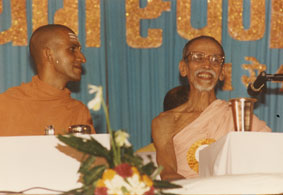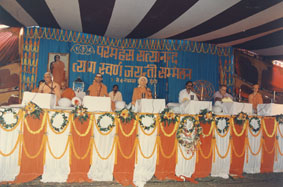
Swami Niranjan and Swami Chidananda Saraswati
The 1993 World Yoga Convention celebrated the 50th year of Sri Swami Satyananda’s renunciation, and was conducted by Swami Niranjan, the President of the Bihar School of Yoga and Sri Swami Satyananda’s spiritual successor.
Following the 1993 Convention, yoga began to be developed and applied not only as a scientific and systematic set of practices for particular benefits, but also as a philosophy, a lifestyle, and a way of connecting to the higher purpose of human life.
Swami Niranjan and Swami Chidananda Saraswati, President of the Divine Life Society, Rishikesh, inaugurated the proceedings. Representatives from thirty-two countries of the world and from twenty states of India, educationists, scientists, artists, yoga researchers, scholars, distinguished spiritual personalities and heads of eminent sannyasa and yoga institutions participated in this gathering of about 12,000 people. Many eminent scholars and spiritual personalities gathered to present an inspiring program, including:

Poorna Kumbha Abhisheka of Swami Niranjan
A highlight and sacred event of the Convention was the performance of the vedic Sudarshan Yajna, propitiating Vishnu, the sustainer of the universe, with acharyas of Sringeri Math conducting the yajna for the wellbeing of all humanity. All were blessed by the large gathering of saints and savants, marking a new era of spiritual awakening with the dawn of the 21st century.
On the completion of the yajna, poorna kumbha abhisheka of Swami Niranjan was performed by the luminaries of the sannyasa tradition in recognition of him as the spiritual successor of Sri Swami Satyananda.
The theme of the Convention was the “Integration of Science and Yoga in the 21st Century”. In the wake of the 1973 World Yoga Convention, many researchers were inspired to conduct scientific research into the effects of yogic practices on the mind and body.
In the years that followed researchers explored and demonstrated how the practices of yoga can be used for therapeutic purposes for a range of conditions, such as asthma, hypertension, diabetes, cancer, and also pregnancy. At the 1993 Convention, recent research findings were presented, and possible solutions to the problems and ills of society and the individual considered.
Among the featured topics were:
The daily program included:

1993 World Yoga Convention: Tyag Golden Jubilee Celebration
The blueprint of a new cultural revolution of yoga was finalized in the form of a Charter, and all those present were given the opportunity to become messengers of peace and the yogic vision.
As well as providing new impetus for yogic research, this Convention inspired new and creative applications of yoga in society. A renewed inspiration, energy and focus was seen in the teaching and training being carried out by independent teachers, yoga centres, yoga schools and yoga ashrams in all parts of India and the world.
